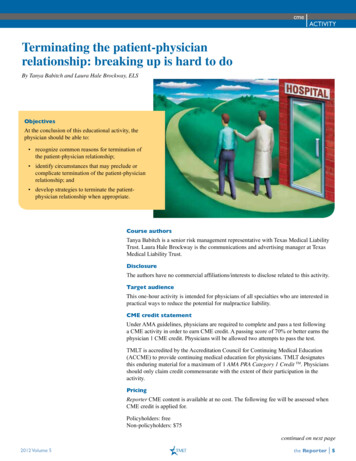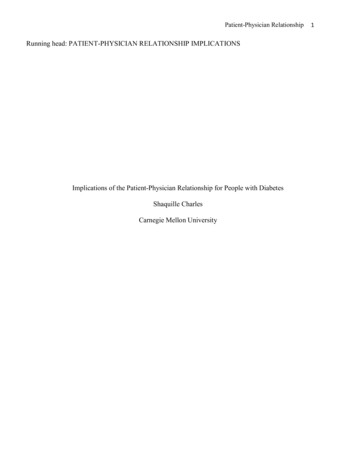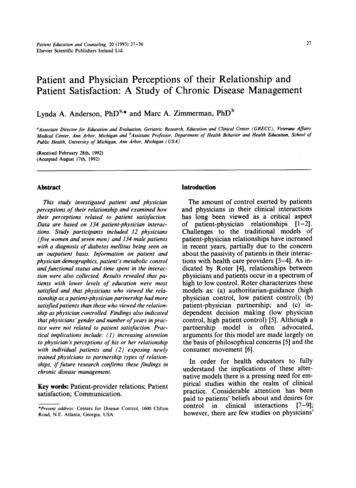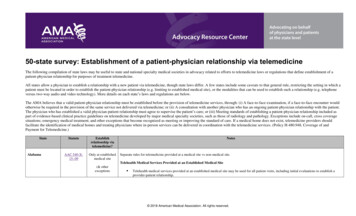
Transcription
cmeACTIVITYTerminating the patient-physicianrelationship: breaking up is hard to doBy Tanya Babitch and Laura Hale Brockway, ELSObjectivesAt the conclusion of this educational activity, thephysician should be able to: recognize common reasons for termination ofthe patient-physician relationship; identify circumstances that may preclude orcomplicate termination of the patient-physicianrelationship; and develop strategies to terminate the patientphysician relationship when appropriate.Course authorsTanya Babitch is a senior risk management representative with Texas Medical LiabilityTrust. Laura Hale Brockway is the communications and advertising manager at TexasMedical Liability Trust.DisclosureThe authors have no commercial affiliations/interests to disclose related to this activity.Target audienceThis one-hour activity is intended for physicians of all specialties who are interested inpractical ways to reduce the potential for malpractice liability.CME credit statementUnder AMA guidelines, physicians are required to complete and pass a test followinga CME activity in order to earn CME credit. A passing score of 70% or better earns thephysician 1 CME credit. Physicians will be allowed two attempts to pass the test.TMLT is accredited by the Accreditation Council for Continuing Medical Education(ACCME) to provide continuing medical education for physicians. TMLT designatesthis enduring material for a maximum of 1 AMA PRA Category 1 Credit TM. Physiciansshould only claim credit commensurate with the extent of their participation in theactivity.PricingReporter CME content is available at no cost. The following fee will be assessed whenCME credit is applied for.Policyholders: freeNon-policyholders: 75continued on next page2012 Volume 5the Reporter 5
theR EPORTEREthics statementThis course has been designated by TMLT for 1 credit in medicalethics and/or professional responsibility.InstructionsYou have two options to obtain CME credit from this activity.Option 1 – onlineComplete Reporter CME test and evaluation forms online. Afterreading the article, go to www.tmlt.org/reporterCME. Click on“Earn CME” under “Terminating of the physician-patient relationship” (2012 Volume 5). Follow the instructions to completethe test and evaluation forms. Your CME certificate will beemailed to you. Please allow up to 4 weeks for delivery of yourcertificate.Option 2 – on paperPlease read the entire article and answer the CME test questionson the paper test forms on page 12. To receive credit, submit thecompleted test and evaluation forms to TMLT. All test questionsmust be completed. Please print your name and address clearly.Allow 4 to 6 weeks from receipt of test and evaluation form fordelivery of the certificate.Questions? Please call the TMLT Risk Management Departmentat 800-580-8658, ext. 5919.Estimated time to complete activityIt should take approximately 1 hour to read this article andcomplete the questions.Release/review dateThis activity is released on October 1, 2012 and will expire onOctober 1, 2015. Please note that this CME activity does notmeet TMLT’s discount criteria. Physicians completing this CMEactivity will not receive a premium discount.IntroductionOne of the unique challenges of practicing medicine is decidingwhen the patient-physician relationship has reached the end ofthe road. Coming to the conclusion that it is time to part wayswith a patient is never easy for physicians and is often accompanied by conflicted feelings. While medicine is a business, it is abusiness that comes with an ethical duty to patients. No physicianis immune from the instinct to continue helping and caring forpatients, even when it becomes difficult to do so.Physicians vary a great deal in how they manage challengingpatients — some choose to continue care and some find that theyfeel most comfortable ending the relationship. Neither is right orwrong, but physicians are within their rights to end a relationship that is no longer therapeutic. At the same time, however,physicians are obligated to “do no harm” to their patients. Priorto termination of the relationship, physicians should evaluate thecase to ensure that the patient is not at a critical stage in treatment, will be given appropriate notice, and has the opportunity tofind another physician.6 the ReporterFormal termination of a patient-physician relationship is onlyrequired if a relationship has actually been established. Once arelationship has been established, a physician owes the patient aduty of care. There may be some situations in which the formation of a relationship is nebulous. Physicians should assume thata relationship exists if they have offered any treatment — evenif not in person. Advice given over the telephone or throughelectronic means is still medical advice and may establish a relationship. If in doubt, it is prudent to assume the relationship hasbeen established and a duty to care for the patient exists.Ending the relationship without appropriate notice could beconsidered a breach of this duty. “The patient-physician relationship is the result of a contract, express or implied, between aphysician and patient that is voluntary and arises when a patientrequests and is supplied medical information/treatment.” 1 Whileboth physician and patient have the right to terminate the relationship, the requirements for ending the relationship are morecomplicated for physicians.Risks of failing to terminate the relationshipappropriatelyThe Texas Medical Association’s Board of Councilors ethicsopinion on termination of the patient-physician relationshipstates, “The patient-physician relationship is wholly voluntary innature and therefore may be terminated by either party. However,physicians have an ethical obligation to support continuity of carefor their patients. Thus, it is unethical for a physician to terminate the patient-physician relationship without first providingreasonable notice under existing circumstances of the physician’sintent to terminate the professional relationship. To terminatethe patient-physician relationship without such notice may resultin civil liability for abandonment.” 2 In addition, lack of appropriate notice to the patient may put the physician at risk for apatient complaint and possible disciplinary action from the TexasMedical Board.Reasons to end the relationshipPatient noncompliance with recommended treatment is acommon reason physicians give for dismissing patients. Otherreasons include failure to keep appointments, abusive or rudebehavior to the physician or staff, or because the patient hasan outstanding balance they do not attempt to pay. In addition,patient commitment of prescription fraud or failing to complywith the requirements of a pain management contract may bea cause for termination of the relationship. All of these reasonsare acceptable, but some exceptions may apply. Physicians areencouraged to review possible termination on a case-by-casebasis; one policy may not fit all when it comes to ending a relationship with a patient.Proceed with cautionPhysician practices are subject to state and federal civil rightslaws. “A physician may decline to undertake the care of a patientwhose medical condition is not within the physician’s currentcompetence. However, physicians who offer their services to the2012 Volume 5
public may not decline to accept patients because of race, color,religion, national origin, sexual orientation, gender identity, orany other basis that would constitute invidious discrimination.” 3-4Additionally, a patient cannot be dismissed because he or she hasbeen diagnosed with HIV/AIDS. 4Discrimination against patients with disabilities is prohibitedby the Americans with Disabilities Act, and termination of therelationship due to the patient’s disability would be considereddiscriminatory. “The ADA prohibits places of public accommodation, such as physician offices, from discriminating againstdisabled individuals in the provision of goods and services adeaf patient successfully sued his physician for discriminationunder the ADA after being discharged as a patient. The dischargeoccurred because the physician lost the only employee in hisoffice who could communicate with the patient in sign language.The court held that instead of firing the patient, the physicianshould have made a reasonable effort to accommodate himby furnishing him written materials or using other methods tofacilitate communication.” 5 (For more on ADA requirements forphysicians, please see article on page 1.)Insurance providers may require that physicians either contactthem or get permission to terminate the relationship beforeending the relationship. Contracts with providers may requirethat physicians provide care to all covered patients, and may haverequirements about “firing” a patient. Physicians should reviewcontracts so that they are aware of any limitations or restrictionsabout ending the patient-physician relationship.Hospital call requirements generally do not allow an on-callphysician to refuse care to a patient — even if the patient haspreviously been dismissed from the on-call physician’s outpatientpractice. If a physician is taking formal call for a hospital, bylawsor hospital contracts generally require that the physician care forthe patient.Physicians should review hospital call requirements so that theyare familiar with what they have agreed to. If an on-call physiciantreats a patient that he or she has previously terminated, it maybe prudent to inform the patient that the hospital care does notre-establish the relationship once the patient has been discharged.Termination for nonpaymentPhysicians are entitled to end relationships with patients whorefuse to pay their bills. However, physicians are discouragedfrom setting up blanket policies that allow staff to terminate relationships for nonpayment without physician review of the case.There may be circumstances in which the physician is aware butthe staff is not. For example, a physician may know that a patientis undergoing a financial hardship, that a patient was not satisfied with his or her care, or that there was an outcome that wasless than desirable. Careful review of the patient’s record beforesending a termination letter may mitigate patient complaints, andcould ward off a Texas Medical Board complaint. There are timesthat physicians may review the case and determine that they arewilling to work with the patient on payment.2012 Volume 5cmeACTIVITYWhile it is reasonable to terminate the relationship for nonpayment, physicians should not refuse appointments to existingpatients for nonpayment. “A physician should not deny an established patient an appointment or cancel an appointment becauseof an unpaid balance. This results in a person being considereda patient one day and not another, depending on how the officestaff feel about the size of the unpaid balance. As long as thepatient-physician relationship is established and not definitivelyterminated, a physician owes the patient the same duty of care,otherwise there is a danger of abandonment.” 6Physicians are encouraged to offer counseling and payment plansto patients before dismissal for nonpayment. These efforts shouldbe documented in the billing portion of the patient’s record. Ifefforts to collect are unsuccessful, practices may wish to send awarning letter that explains failure to pay the outstanding balancemay result in termination of the patient-physician relationship.(Please see sample letter on page 10.)If the patient does not contact the office in response to the firstletter, send a second letter stating that the patient-physician relationship has been terminated. (Please see sample letter on page10.) If the patient does contact the office and requests copies ofthe medical records, be aware that the patient’s medical recordcannot be withheld from another physician or from the patientbecause of an overdue account.Difficult situationsTerminating the patient-physician relationship while the patientis in the postoperative period or in an acute medical episodeis generally not recommended. Physicians should, wheneverpossible, care for the patient until they are safely through thepostoperative period or acute episode — unless they can findanother physician who will accept the patient and can facilitate aseamless transfer of care.It may also be difficult to discharge a patient in the lasttrimester of pregnancy. It may not be feasible for these patientsto find another physician who will accept them past 28 weeks. Ifa transfer of care is arranged, the physician should document thename of the new physician, that the records were sent, and thatthe patient has an appointment with the new physician.If a transfer of care cannot be arranged, it is likely that a physician will need to continue treating the patient through thepostpartum period. Additionally, before terminating the relationship with a pregnant patient, physicians should consider that theircall duties may eventually require them to deliver a baby for apatient who has been dismissed from the practice.Termination of the relationship with pediatric patients presentsa challenge for physicians. Noncompliance and nonpayment arenot generally the patients’ fault or responsibility. If it is possibleto work with the parents to improve compliance, physicians areencouraged to try. Noncompliance should be well documentedin the chart. If parents are noncompliant with treatment recommendations to an extent that the patient may be harmed, it mayrequire a call to Child Protective Services instead of simplythe Reporter 7
theR EPORTERterminating the relationship. If the physician’s relationship withparents is untenable, it is reasonable to dismiss the patient fromthe practice.Patients with mental health issues may require extra patienceon the part of the physician. Physicians should avoid terminatingthe relationship with a patient in a psychiatric crisis or withsuicidal thoughts. If the treating physician is a psychiatrist, thephysician “should also discuss why he does or does not believeit is important for the patient to continue in treatment, and thepotential risks of not continuing treatment. This is particularlyimportant when discussing continuing medications: for example,abruptly stopping some psychiatric medications can carry significant medical risks. The psychiatrist should be wary of prescribinglarge amounts of medications around the time of termination.If the patient experiences an adverse reaction to the medicationbut is not yet under the care of another psychiatrist, the originalpsychiatrist may be found liable even if the proper terminationprocess was followed.The most conservative approach is not to prescribe beyond thetermination date. It is important to remember, however, that thisprocess must be tailored to the needs of the individual patient.So, in a case where the psychiatrist makes a medical decision to prescribe or refill after termination, the implications forthe termination process should be clear to the psychiatrist andcommunicated to the patient. The termination date may need tobe extended or, possibly, the entire termination process begunagain.” 7Rural providers may find it more difficult to dismiss patientsdue to a lack of available specialists. If a patient needs continuedcare and there are no other physicians to provide it, physiciansmay need to be flexible. Offering payment plans to patientsfacing financial hardship and continuing to treat noncompliantpatients may be necessary.If a patient has filed a lawsuit or a complaint with the TexasMedical Board against a physician, the physician cannot assumethat the relationship has automatically ended. Physicians are notrequired to end the relationship with a patient who has sued themor filed a complaint — although many wish to do so as soonas possible. If a physician feels he or she can offer the patientquality care without bias, the physician may decide to continuethe relationship. If a physician wants to dismiss a patient (andthere is indication that a patient plans to return to the practice),ending the relationship will still require formal termination vialetter, with appropriate notice.Steps for appropriate terminationRisk managers recommend that physicians develop a standardized process for dismissing patients. “Our process providespatients with plenty of opportunities to reconsider their behaviorand re-engage in the relationship, when appropriate, and itprovides the physician and staff the assurance that comes withfollowing a reasoned, consistent approach when difficult circumstances arise.” 88 the ReporterPrior to termination, physicians may wish to try counseling thepatient to improve noncompliant or disruptive behavior. Anycounseling should be documented in the patient’s record. In addition, a warning that the continued behavior may mean an end tothe patient-physician relationship may be a surprise to the patient.Physicians who are tempted to forego the counseling process maybe missing an opportunity to understand the cause of the patient’snoncompliance. “Taking time to sit down with the patient withthe goal of better understanding expectations or needs that aredriving his or her behavior can be valuable. Some patients haveunreasonable expectations, but for others, understanding the pointthey’re trying to make can go a long way in repairing the relationship. Learning about the root cause of their dissatisfaction canhelp us improve the delivery of care to all our patients.” 8A similar counseling process should be employed for patientswho miss appointments or who exhibit rude behavior. “Directstatements such as, ‘If you do this again, we will no longer carefor you, and you will have to go to another practice,’ can be quiteeye-opening for some patients.” 8 Again, document these discussions in the medical record.If the counseling process is not effective and the physiciandecides to dismiss the patient, the next step is to send a dismissalletter to the patient. The letter should be printed on office letterhead and sent by first-class mail and by certified mail with areturn receipt requested. The dismissal letter should include thefollowing elements. It should include a statement that the patient-physicianrelationship will terminate in a specified time period anda recommendation that the patient find another physician.The time limit given in the letter will depend on severalfactors such as physician specialty, size of community, andavailability of other physicians. The patient should be givena reasonable amount of time to find a new physician. Thecurrent physician should remain available for care until thespecified time period elapses. While the American Medical Association suggests“providing the patient with a brief explanation for terminating the relationship,” 9 physicians are not required tostate a reason for the termination. Any potentially inflammatory remarks should be left out of termination letters.Angry words to a patient — especially in writing — couldbe damaging to a physician. It may be more advantageousto exclude specific reasons or to include only neutral statements. While composing termination letters, physicians maywish to consider whether they would be comfortable withthe wording of the termination letter if it were later reviewedby the Texas Medical Board, an attorney, or a jury. Describe in general terms how the patient can locate anew physician. It is not advisable to name a specific physician, clinic, or group. Refer the patient to their insurancecompany’s list of providers, county medical society, or aphysician-referral service.2012 Volume 5
Patient termination —frequently asked questionsQ: I saw a patient for prenatal care, but she was noncompliant in keeping her appointments. I formally ended therelationship with her (with appropriate notice) during thesecond trimester of pregnancy. She began seeing anotherlocal obstetrician whom I share call with. She is now atthe hospital, and I have been called to deliver her baby.Am I required to do so, since I ended our relationship?A: Your call agreement probably requires that you do so.Although you ended the relationship, if you share callwith her current physician, you assume the duty to carefor his patients when needed. Unless you have worked outspecial coverage with the other physician in these types ofcases, you are most likely obligated to respond. However,it is reasonable to ask the patient to return to her physician for postpartum care; she is still his patient.Q: I am a pediatrician and I see a child whose parents aredivorced. The parents have joint custody and disagreeon almost all aspects of care. We receive angry callsfrom one parent or the other after almost every appointment. It is not the patient’s fault, but the situation hasbecome unpleasant for my staff and I. May I terminate therelationship?A: You may wish to try to discuss the issues with eachof the parents to improve the situation. But if a resolution cannot be reached, it is acceptable to terminate therelationship. It is recommended that you wait until thechild is well and does not have a scheduled appointmentto send dismissal letters to the parents.Q: I am an internist and have been seeing a patientfor several years for chronic health issues. Recently,I received a written request that the record be sent toanother local internist. The records request indicated thatit was for a “transfer of care.” Since it appears that thepatient has decided to change physicians, do I need tosend a termination letter?A: If it seems clear that the patient has chosen to seeanother physician, consider sending a confirmation thatthe patient has ended the relationship with you. (Pleasesee sample letter on page 10). If you would rather notgive the patient the option of coming back to you, sendinga letter that confirms the termination of the patientphysician relationship “closes the loop.” If you would bewilling to see the patient again, ask staff to call the patientand confirm that the patient has transferred care to anotherphysician. This clarifies that the patient is receiving careelsewhere and that follow-up care has not been neglected.Any communication regarding the patient’s transfer (bytelephone or by letter) should be documented in the chart.2012 Volume 5cmeACTIVITY Include an authorization for the release of the medical recordand advise the patient to designate the new physician assoon as determined, sign the form, and send it to your officepromptly. Indicate in the letter that the record will be copiedand forwarded to the physician as soon as possible. Since youare ending the relationship with the patient, you may chooseto forego copying charges for the medical record to avoidengendering additional bad feelings. Additionally, physicians may not withhold a copy of thepatient’s medical record because of an outstanding accountbalance.Keep a copy of the dismissal letter and the return receipt in thepatient’s medical record. Once the time period specified in theletter has passed, the physician no longer has to treat the patient.You are not required to dismiss noncompliant or difficult patientsPhysicians with nonpaying or noncompliant patients may sometimes choose to keep a patient. Patients may have financial orsocial limitations that the physician sympathizes with. In thesecases, there is no requirement to end the relationship. However,if continuing treatment with a noncompliant patient, documentation is extremely important. In the event of a poor medicaloutcome, the medical record will become a physician’s bestdefense against allegations of inadequate care.The patient’s repeated noncompliance should be documented indetail, and all the physician’s recommendations and steps taken toassist the patient in his or her treatment should be included in therecord. In particular, physicians should carefully document thatthey repeated the treatment recommendations, that the patient wasunwilling or unable to comply, and that they discussed the risks ofnoncompliance at length.Confirming when the PATIENT ends the relationshipwith YOUWhen a patient notifies the physician or staff that the patient doesnot intend to return to the practice, confirm it by sending a letter tothe patient. Since it is likely that you share the patient’s desire thatthey not return, it may be beneficial to formally close any loopholes. TMLT’s risk management department receives numerouscalls about patients who have angrily stated that they will nevercome back to a practice — and then they call for another appointment. If a patient orally ends a relationship and the physician iscertain that they would also like to end the relationship, formalwritten confirmation is recommended.If physicians are part of a group practice, consider formallyterminating the patient’s relationship with the group — not justone physician. If other physicians in the group would prefer not tosee the patient, the termination letter should clearly state that therelationship with both the physician and the group are ending.continued on page 11the Reporter 9
theR EPORTERSample termination lettersWhen a physician decides to dismiss a patient, the patient should be notified in writing. The letter should be printed on office letterhead and sent by first-class mail and by certified mail with a return receipt requested. A blank authorization to release medical recordsshould be enclosed.Termination of the physician-patient relationshipDate[patient address]Certified receipt #Also sent first-class mail.Dear [patient name]:Please be advised that I (and/or Group) will no longer beable to treat you as a patient. The termination of our physicianpatient relationship will be effective in 30 days from the date ofthis letter. Your medical condition requires continuing physician supervision, and it is important for you to select anotherphysician as soon as possible.Contact your insurance plan or the county medical society fornames of other physicians. Upon written authorization, a copyof your medical record will be sent to your new physician. Arelease form is enclosed.Date[patient address]Certified receipt #Also sent first-class mail.Dear [patient name]:This letter is sent to confirm your decision to discontinue carewith me. Your medical condition requires physician supervision, and it is important for you to select another physician assoon as possible. I will be available to you until [30 days fromdate of letter].Please contact your insurance plan or the county medical society for names of other physicians. Upon written authorization, Iwill provide a copy of your medical record to your new physician. A release form is enclosed to expedite the process.Sincerely,[physician name]Sincerely,[physician name]Non-payment notice/warningDate[patient address]Confirmation of patient-terminated relationshipCertified receipt #Also sent first-class mail.Termination for non-paymentDate[patient address]Certified receipt #Also sent first-class mail.Dear [patient name]:Dear [patient name]:It has come to my attention that you have received severalletters regarding your outstanding account. If there has beena problem or if you are unhappy with the care that you havereceived in this practice, please contact me to discuss the situation. You are important to us, and I hope we can resolve anyissues you have.My business manager is also available to discuss payment ofyour account or to implement payment arrangements if they areneeded. Should we not hear from you within 30 days, I believethat it would be mutually beneficial to terminate the physician/patient relationship so that you may locate a new physician.On [date], I sent you a letter requesting that you contact thebusiness manager or me regarding any problems that may haveoccurred resulting in non-payment of your account. In theletter, I stated that it would be necessary to terminate our physician/patient relationship if we did not hear from you.Since we have not heard from you, please be advised that I willno longer be able to treat you as a patient. The termination ofour relationship will be effective in 30 days from the date ofthis letter.I hope that we will hear from you in the near future.A release form is enclosed for your written authorization.Please contact us with the name of your new physician so wemay forward your records to his or her office. At that time, youraccount will be closed.Sincerely,[physician name]Sincerely,[physician name]10 the Reporter2012 Volume 5
cmeACTIVITYcontinued from page 9Make sure staff is not left at a disadvantage. Keep staff informedand update systems appropriately. If your scheduling softwareallows alerts, use them! If a formally dismissed patient calls foran appointment, staff will immediately see that the relationshiphas been terminated and can act accordingly. In the alert screen,note the date that the termination letter was sent so staff can judgewhether the patient is calling within the 30-day “window.” If theyare within the 30 days, staff should offer an appointment, but maywish to discuss the situation with the physician.In summary, if done judiciously and with appropriate notice,termination of the patient-physician relationship need not bedetrimental to either party. Careful review of each case by thephysician is key — patients should not be terminated from thepractice “automatically” or as a matter of policy. While physicians must be cautious when ending relationships with patients,it is generally within physicians’ rights to do so.Sources1. Fullbright and Jaworski. Texas Medical Jurisprudence. Part 5, page198. Eighteenth Edition. 2010.2. Texas Medical Association Board of Councilors. CurrentOpinions. Available at http://www.texmed.org/template.aspx?id 392#Termination. Accessed July 25, 2012.3. American Medical Association Council on Ethical and JudicialAffairs. E-9.12 Patient-physician relationship: respect for lawand human rights. Code of Medical Ethics. Updated Jun
nate the patient-physician relationship without first providing reasonable notice under existing circumstances of the physician's intent to terminate the professional relationship. To terminate the patient-physician relationship without such notice may result in civil liability for abandonment." 2 In addition, lack of appro-










